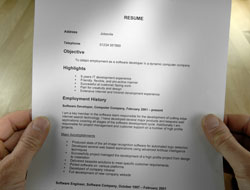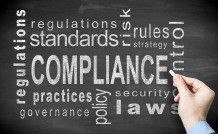Online Class: Writing Effective Emails in the Workplace

no certificate
with CEU Certificate*
-
12Lessons
-
25Exams &
Assignments -
2,857Students
have taken this course -
11Hours
average time -
1.1CEUs
Course Description
Despite the popularity of social media, email continues to be the primary method of business communication. Yet, surprisingly, many workers, from entry-level employees on up to managers, do not practice effective email communication.
Your workplace emails reflect your professionalism and can often make the difference between getting a job, earning a promotion and keeping a job. As we have seen time and time again in the news, your emails are never actually private. They can be forwarded or copied to just about anyone anywhere.
In their haste to participate in instant communication, many workers send out badly written messages that contain typos and other errors. These errors can leave a negative impression on bosses, colleagues, prospective clients and potential employers.
Do you start your workday by checking your email inbox? Do you continue to check it throughout the day? You are not alone. The average office worker sends or receives 121 emails each day, according to a recent report by the Radicati Group, a technology market research firm.
With that volume of messages to wade through, it is easy to fall into lazy habits with your messages.
The great thing about email is that it is quick and easy. The bad thing about email is that you cannot take back a message once it has been sent. Therefore, before you hit the send button on any email, it is important to follow some tried and true principles of good etiquette.
Here are our top 20 important rules for email etiquette.
1. First things last. Have you ever hit "send" before you proofread your message and lived to regret it? We all have. You can avoid this potentially embarrassing situation by waiting to type in your recipient's address until you have finished the message. While you're at it, double check that the address is correct before hitting "send." It is easy to select the wrong name from your contact list. Never guess at the spelling of someone's name. You could be just one letter off and end up sending the email to the wrong person.
2. Include a brief yet clear subject line. With all the messages coming into our inboxes each day, we want to be able to tell quickly which ones to open and which ones to delete. You boost your chances of your message being read by including a direct subject line in all your business correspondence.
Use as few words as possible to convey your point with the range of three to seven words being optimum. Examples include "New meeting schedule," "Follow-up to your proposal" and "Third quarter marketing results." When you use a phrase that lets your reader know your message is important, you show them that you value their time and that you are addressing their business interests. If you are responding to an email with a blank subject, line, go ahead and fill an appropriate one in.
3. Use a professional email address. Your email address reflects much about the sender. If your business email address has a nickname or a cutesy phrase that would be better for a pre-teen, your recipients may have a hard time taking you seriously.
Create an email address that includes your name so that your recipients know at a glance who is writing to them.
4. Use a professional salutation. A professional email should include a professional greeting that is based upon how well you know that individual. Avoid shortening a first name (from David to Dave or Patricia to Pat) unless you are sure the recipient goes by that shortened version.
Use the word "Dear" or "Hello" followed by the person's name, but avoid the overly informal "Hey." In America, we are accustomed to hearing our first names, but it is always appropriate to Use "Mr." or "Ms." followed by the individual's last name as a sign of respect, especially when communicating with someone you do not know.
If the email is going to a large group or if you don't know the name of the person you are addressing, use a polite, yet generic, opener. "To whom it may concern" or "Dear Sir or Madame" are tried and true stand-bys for business correspondence, but they can sound a little stuffy. You could try "Hello," "Good day" or "Greetings" as salutations to unknown individuals. Other options for group emails are "Hello everyone" or "Dear board members."
5. Introduce yourself briefly. Although your email address and subject line will usually do the trick, it does not hurt to identify yourself to your recipient. This can be a brief reference to your title with the company or to when you met the individual. A detailed biography is not necessary. Here's an example: "I am following up on our conversation yesterday at the Chamber of Commerce meeting. I enjoyed talking with you over lunch."
6. Do not write about anything you would not want shared with others. Don't be fooled. There is no such thing as a private email. The fact is that any email can be forwarded and shared with many people. Make it a rule of thumb that you do not send any work-related email that you would not feel comfortable being posted on an office bulletin board. Another way to look at it is not to write anything in an email that you would not hesitate to say to a person's face.
7. If you are angry, wait to send that email. Here's where the accessibility and speed of the technology can get you in big trouble. If you are upset with your boss or with one of your employees, take the time to cool off before you fire off an angry message.
By the same token, do not disparage your colleagues in an email to someone else in the office. Angry emails can take on a life of their own.
8. Watch overuse of exclamation points and ditch the emoticons. Exclamation points should be used sparingly or else your messages can come across as immature or even worse, as angry. Save the smiley faces for your social media posts with friends. They are not professional. Period.
9. Limit all caps. Use your words to emphasize your points rather than using all capital letters. USING ALL CAPS CAN MAKE IT SEEM AS IF YOU ARE SHOUTING. No one wants to be shouted at.
10. Do not share confidential information. Be very careful in sending (or forwarding) sensitive business information. Refrain from sending information that could put someone's identity at risk such as social security numbers of tax information. Be wary of emailing private financial information that could be damaging if it got into the wrong hands.
11. Avoid jargon and be careful with humor. Text-friendly phrases such as "Gr8" and "4U" have no place in business correspondence. They make you look childish. One of the pitfalls of communicating by email is that your reader cannot see your eyes, gestures or facial expressions or hear the tone in your voice. Therefore, your tone can be misinterpreted. As a result, it is a good idea to be very cautious with humor, sarcasm and with slang terms. You don't what to come off as rude or offensive in any way.
12. Get back to people. Don't feel you have to respond to an email immediately. In fact, time management experts agree that checking your email constantly can be a real time waster. One option is to check your inbox three times a day--first thing in the morning, just before or after lunch and just before you leave for the day.
It is important than you get back with your senders in a timely fashion, however. Unless you are dealing with an emergency, it is acceptable to respond within 24 to 48 hours or longer if a weekend is involved.
Similarly, be patient with others who do not get back to you right away.
13. Be careful with "reply all." You know how annoying it can be to get your inbox flooded with unnecessary responses. Do not hit "reply all" unless you are sure everyone needs to see your response. Most of the time, they do not.
14. Don't send an email when you need to talk in person or by phone. Emails are great, but they are not the perfect form of communication. In situations that need explaining or negotiating or just a more personal touch, there is nothing like a face-to-face meeting.
If you need to deliver bad news, an email is not the proper medium. Arrange to meet with the person or at least make a phone call.
Also, avoid using emails as a way to cancel a meeting or an interview at the last minute. There is no way to know the recipient got the message in time.
15. Only use the "high priority" option when the message is really important. It's kind of like the classic "The Boy Who Cried Wolf" story. If you overuse high-priority, it will be difficult for people to take your messages seriously. Evaluate the importance of your e-mail. Instead, let your subject line inform you reader of the significance of the message.
16. Protect your recipients' privacy in group emails. Many people are touchy about who gets their email addresses. To be on the safe side when messaging a large group, use the "BCC" option. BCC stands for blind carbon copy and ensures that email addresses are hidden from view. Simply type your own email address in the To: field and type your recipients'' addresses in the use BCC field.
Keep in mind that this is not a foolproof method. One of your recipients many hit "reply all" and by doing so reveal to everyone that she got the original message.
17. Get to the point. Business emails should be concise. After your brief introduction, you should state the purpose of your message within a sentence or two. Be clear and avoid long, drawn-out explanations. If your recipient needs more information, they can contact you.
18. Include an appropriate closing. Even though you have identified yourself in your introduction and with your email address, a polite email also includes a closing followed by your name. Professional options include "With regards," "All the best," "Looking forward to working with you" and "Many thanks."
Avoid phrase that could sound pretentious (at least for Americans) such as "Ciao!" or "Cheers!" or ones that sound overly friendly or informal such as "Hugs" or "Love."
19. Make it easy to contact you. Always include your full name and contact information at the end of your business emails. Your email signature is a good way to let your recipients know more about you. Include the name of your company, your title and your phone number. It's also a great place to add a link to your website and social media pages.
20. Proofread. Proofread. Proofread. Read over your emails before sending them. Do not rely on spell checkers because they don't catch many mistakes. For example, "Sorry for the inconvenience" could be auto-corrected to "Sorry for the incontinence." Try reading your message aloud to help you catch errors.
Think of your email correspondence as a reflection of you. If your emails are sloppy or sound rushed, your recipients will think you are careless in your work. If your emails are filled with errors, your readers will think that is how you conduct business.
On the other hand, if your emails are friendly, yet professional, in tone and clearly written, you will convey a sense of competence that will carry over into their dealings with you.
It may sound as if it goes without saying, but be sure to read an email that you receive carefully before replying to it. We are all busy, but you can do your reputation considerable harm by dashing off a response in haste without fully reading the original message.
- Completely Online
- Self-Paced
- Printable Lessons
- Full HD Video

- 6 Months to Complete
- 24/7 Availability
- Start Anytime
- PC & Mac Compatible
- Android & iOS Friendly
- Accredited CEUs

Course Lessons
Lesson 1: Email Etiquette
 Lesson 1 Video
Lesson 1 Video Lesson discussions: Reasons for Taking this Course
Lesson discussions: Reasons for Taking this Course Complete Assignment: An Introduction
Complete Assignment: An Introduction Complete: Lesson 1 Assignment
Complete: Lesson 1 Assignment Assessment: Exam 1
Assessment: Exam 1
Lesson 2: Tips to Writing Effective E-mails
 Lesson 2 Video
Lesson 2 Video Complete: My Business Email that Gets Read - Lesson 2 Assignment
Complete: My Business Email that Gets Read - Lesson 2 Assignment Assessment: Exam 2
Assessment: Exam 2
Lesson 3: How to Say it Right the First Time
 Lesson 3 Video
Lesson 3 Video Complete: Lesson 3 Assignment
Complete: Lesson 3 Assignment Assessment: Exam 3
Assessment: Exam 3
Lesson 4: Developing Your Own Style
 Lesson 4 Video
Lesson 4 Video Complete: Examples of Tone in Emails - Lesson 4 Assignment
Complete: Examples of Tone in Emails - Lesson 4 Assignment Assessment: Exam 4
Assessment: Exam 4
Lesson 5: Common Grammatical Errors
 Lesson 5 Video
Lesson 5 Video Complete: Lesson 5 Assignment
Complete: Lesson 5 Assignment Assessment: Exam 5
Assessment: Exam 5
Lesson 6: Business Letters Template
 Lesson 6 Video
Lesson 6 Video Complete: Lesson 6 Assignment
Complete: Lesson 6 Assignment Assessment: Exam 6
Assessment: Exam 6
Lesson 7: Writing Results-Oriented Letters (Sales and Marketing and other Media Relations)
 Lesson 7 Video
Lesson 7 Video Complete: Lesson 7 Assignment
Complete: Lesson 7 Assignment Assessment: Exam 7
Assessment: Exam 7
Lesson 8: Writing Results-Oriented Job Search E-mails
 Lesson 8 Video
Lesson 8 Video Assessment: Exam 8
Assessment: Exam 8
Lesson 9: Writing Results-Oriented Letters: Customer Relations
 Lesson 9 Video
Lesson 9 Video Complete: Lesson 9 Assignment
Complete: Lesson 9 Assignment Assessment: Exam 9
Assessment: Exam 9
Lesson 10: Writing Results-Oriented Letters: Placing and Acknowledging Orders
 Lesson 10 Video
Lesson 10 Video Complete: Lesson 10 Assignment
Complete: Lesson 10 Assignment Assessment: Exam 10
Assessment: Exam 10
Lesson 11: Writing the Extended E-mail (Reports and Proposals)
 Lesson 11 Video
Lesson 11 Video Complete: Lesson 11 Assignment
Complete: Lesson 11 Assignment Assessment: Exam 11
Assessment: Exam 11
Lesson 12: Writing a Short Report (Making and Supporting Your Idea)
 Lesson 12 Video
Lesson 12 Video Lesson discussions: Your Opinion Matters: Course Rating; Course Comments; Program Evaluation Follow-up Survey (End of Course)
Lesson discussions: Your Opinion Matters: Course Rating; Course Comments; Program Evaluation Follow-up Survey (End of Course) Complete: Write a Short Report Email - Final Assignment
Complete: Write a Short Report Email - Final Assignment Assessment: Exam 12
Assessment: Exam 12 Assessment: The Final Exam
Assessment: The Final Exam
Learning Outcomes
- Describe email etiquette.
- Describe methods for developing your own style.
- Recognize common grammatical errors.
- Demonstrate using business letters template.
- Demonstrate writing results-oriented letters (sales and marketing and other media relations).
- Demonstrate writing results-oriented job search e-mails.
- Demonstrate writing results-oriented letters.
- Demonstrate writing results-oriented letters.
- Demonstrate writing the extended e-mail (reports and proposals).
- Demonstrate writing a short report (making and supporting your idea).
- Demonstrate mastery of lesson content at levels of 70% or higher.
Additional Course Information

- Document Your Lifelong Learning Achievements
- Earn an Official Certificate Documenting Course Hours and CEUs
- Verify Your Certificate with a Unique Serial Number Online
- View and Share Your Certificate Online or Download/Print as PDF
- Display Your Certificate on Your Resume and Promote Your Achievements Using Social Media

Choose Your Subscription Plan
No Certificate / No CEUs
This course only
| Includes certificate | X |
| Includes CEUs | X |
| Self-paced |

|
| Instructor support |

|
| Time to complete | 6 months |
| No. of courses | 1 course |
Certificate & CEUs
This course only
| Includes certificate |

|
| Includes CEUs |

|
| Self-paced |

|
| Instructor support |

|
| Time to complete | 6 months |
| No. of courses | 1 course |
Certificates & CEUs
Includes all 600+ courses
| Includes certificate |

|
| Includes CEUs |

|
| Self-paced |

|
| Instructor support |

|
| Time to complete | 12 Months |
| No. of courses | 600+ |
Certificates & CEUs
Includes all 600+ courses
| Includes certificate |

|
| Includes CEUs |

|
| Self-paced |

|
| Instructor support |

|
| Time to complete | 24 Months |
| No. of courses | 600+ |
Student Testimonials
- "This course has helped to understand how important it is to write correctly in an email to the reader and what to say in order for them to open up the email and how to think as the other person that is reading the email. I was glad to take this class with this instructor because it was a pleasure taking and understanding all of the material." -- Corliss P.
- "Hello, Thank you for requesting my opinion. I think the course is well put together. The information flows, in a simple and comprehendible style. The examples provided enhanced each lesson. Most of the supporting links were very helpful; however some did not pertain to the topic at hand. Overall, this has been an informative course that teaches you practical skills. Considering some of the emails I have received and the mistakes I myself have made in sending emails. I would give this course a glowing recommendation to everyone." -- Celine R.
- "It was very helpful and enlightening. I was interested in the various types of emails and the amount of thought that goes into each." -- Joseangel S.
- "I thought it was a great course, it covered a lot of different scenarios and was fairly easy to follow." -- Naomi P.
- "I very much enjoyed the course. It was straight forward and easy to learn. The lessons were presented nicely with a lot of helpful information to take into the workplace." -- Jacqueline P.
- "This class provided a current and up-to-date wealth of knowledge for writing emails. I had no idea employers are looking for employees that can write business reports! I had no idea how to write one until I discovered this course. I feel I can re-enter the workforce with confidence once again!" -- Lisa P.
- "I enjoyed this course. The course touched on pretty much all the different emails I would write up. I found the course easy to read and understand. Thank You to the instructors!" -- Laurie T.
- "I thought the course was very helpful. I had no idea the subject line was so important. The course is very thorough." -- Sean K.
- "I believe that this course was helpful and informative. There is a lot that needs to be considered when sending emails, and I think that everyone can value from this course." -- Ashley K.
- "I learned so many things about how to create a professional email that will get noticed and, acted upon. Even the things that are not a necessary part of my job (such as writing a report) were still presented in an interesting manner that I was able to learn from." -- Kathy O.
Related Courses
-
 87 hours
8.7 CEUs
Writing Help Course Bundle
$135.00
87 hours
8.7 CEUs
Writing Help Course Bundle
$135.00
-
 17 hours
1.7 CEUs
ESL Basic Grammar and Writing
$95.00
17 hours
1.7 CEUs
ESL Basic Grammar and Writing
$95.00
-
 29 hours
2.9 CEUs
Human Resources Productivity Course Bundle
$120.00
29 hours
2.9 CEUs
Human Resources Productivity Course Bundle
$120.00
-
 36 hours
3.6 CEUs
Ultimate Secretary Training Bundle
$150.00
36 hours
3.6 CEUs
Ultimate Secretary Training Bundle
$150.00
-
 52 hours
5.2 CEUs
ESL Grammar Skills: Level 1-5 Course Bundle
$175.00
52 hours
5.2 CEUs
ESL Grammar Skills: Level 1-5 Course Bundle
$175.00
-
 45 hours
4.5 CEUs
Event Management Course Bundle
$145.00
45 hours
4.5 CEUs
Event Management Course Bundle
$145.00
-
 12 hours
1.2 CEUs
Writing Effective Persuasion
$95.00
12 hours
1.2 CEUs
Writing Effective Persuasion
$95.00
-
 5 hours
0.5 CEUs
Business Coaching
$95.00
5 hours
0.5 CEUs
Business Coaching
$95.00
-
 8 hours
0.8 CEUs
Procurement Management
$95.00
8 hours
0.8 CEUs
Procurement Management
$95.00
-
 6 hours
0.6 CEUs
General Receptionist
$95.00
6 hours
0.6 CEUs
General Receptionist
$95.00
-
 10 hours
1.0 CEUs
Travel Writing 101
$95.00
10 hours
1.0 CEUs
Travel Writing 101
$95.00
-
 8 hours
0.8 CEUs
Teaching Grammar to ESL Students
$95.00
8 hours
0.8 CEUs
Teaching Grammar to ESL Students
$95.00
-
 7 hours
0.7 CEUs
Speed Reading 101
$95.00
7 hours
0.7 CEUs
Speed Reading 101
$95.00
-
 5 hours
0.5 CEUs
Vocabulary Building
$95.00
5 hours
0.5 CEUs
Vocabulary Building
$95.00
-
 7 hours
0.7 CEUs
Financial Analysis 101: Planning and Control
$95.00
7 hours
0.7 CEUs
Financial Analysis 101: Planning and Control
$95.00
-
 12 hours
1.2 CEUs
Romance Writing
$95.00
12 hours
1.2 CEUs
Romance Writing
$95.00
-
 8 hours
0.8 CEUs
Motivational and Public Speaking 101
$95.00
8 hours
0.8 CEUs
Motivational and Public Speaking 101
$95.00
-
 5 hours
0.5 CEUs
Recruitment and Retention Strategies
$95.00
5 hours
0.5 CEUs
Recruitment and Retention Strategies
$95.00
-
 9 hours
0.9 CEUs
Mystery Writing
$95.00
9 hours
0.9 CEUs
Mystery Writing
$95.00
-
 9 hours
0.9 CEUs
Business Management
$110.00
9 hours
0.9 CEUs
Business Management
$110.00
-
 5 hours
0.5 CEUs
Communication with Diplomacy and Tact
$95.00
5 hours
0.5 CEUs
Communication with Diplomacy and Tact
$95.00
-
 5 hours
0.5 CEUs
Developing Great Social Skills
$95.00
5 hours
0.5 CEUs
Developing Great Social Skills
$95.00
-
 5 hours
0.5 CEUs
Kaizen 101 - An Introduction
$95.00
5 hours
0.5 CEUs
Kaizen 101 - An Introduction
$95.00
-
 6 hours
0.6 CEUs
Delegation Skills
$95.00
6 hours
0.6 CEUs
Delegation Skills
$95.00
-
 7 hours
0.7 CEUs
Marketing for Small Business 101
$95.00
7 hours
0.7 CEUs
Marketing for Small Business 101
$95.00
-
 9 hours
0.9 CEUs
Product Management 101
$95.00
9 hours
0.9 CEUs
Product Management 101
$95.00
-
 11 hours
1.1 CEUs
English Composition 101
$95.00
11 hours
1.1 CEUs
English Composition 101
$95.00
-
 5 hours
0.5 CEUs
How to Write a Business Plan
$95.00
5 hours
0.5 CEUs
How to Write a Business Plan
$95.00
-
 5 hours
0.5 CEUs
Internet Marketing Basics
$95.00
5 hours
0.5 CEUs
Internet Marketing Basics
$95.00
-
 5 hours
0.5 CEUs
Basic Research Skills
$95.00
5 hours
0.5 CEUs
Basic Research Skills
$95.00
-
 7 hours
0.7 CEUs
How to Win Arguments
$95.00
7 hours
0.7 CEUs
How to Win Arguments
$95.00
-
 8 hours
0.8 CEUs
Community Development 101
$95.00
8 hours
0.8 CEUs
Community Development 101
$95.00
-
 7 hours
0.7 CEUs
Organizational Behavior in Business
$95.00
7 hours
0.7 CEUs
Organizational Behavior in Business
$95.00
-
 6 hours
0.6 CEUs
Job Performance Appraisals - A How To Guide
$95.00
6 hours
0.6 CEUs
Job Performance Appraisals - A How To Guide
$95.00
-
 7 hours
0.7 CEUs
Business Analysis
$95.00
7 hours
0.7 CEUs
Business Analysis
$95.00
-
 6 hours
0.6 CEUs
Management Essentials
$95.00
6 hours
0.6 CEUs
Management Essentials
$95.00
-
 7 hours
0.7 CEUs
Creating an Effective Sales Team
$95.00
7 hours
0.7 CEUs
Creating an Effective Sales Team
$95.00
-
 12 hours
1.2 CEUs
ESL Grammar Skills Level 1
$95.00
12 hours
1.2 CEUs
ESL Grammar Skills Level 1
$95.00
-
 5 hours
0.5 CEUs
Creating and Managing a Non-Profit Organization
$95.00
5 hours
0.5 CEUs
Creating and Managing a Non-Profit Organization
$95.00
-
 14 hours
1.4 CEUs
Creative Writing for Beginners
$95.00
14 hours
1.4 CEUs
Creative Writing for Beginners
$95.00









